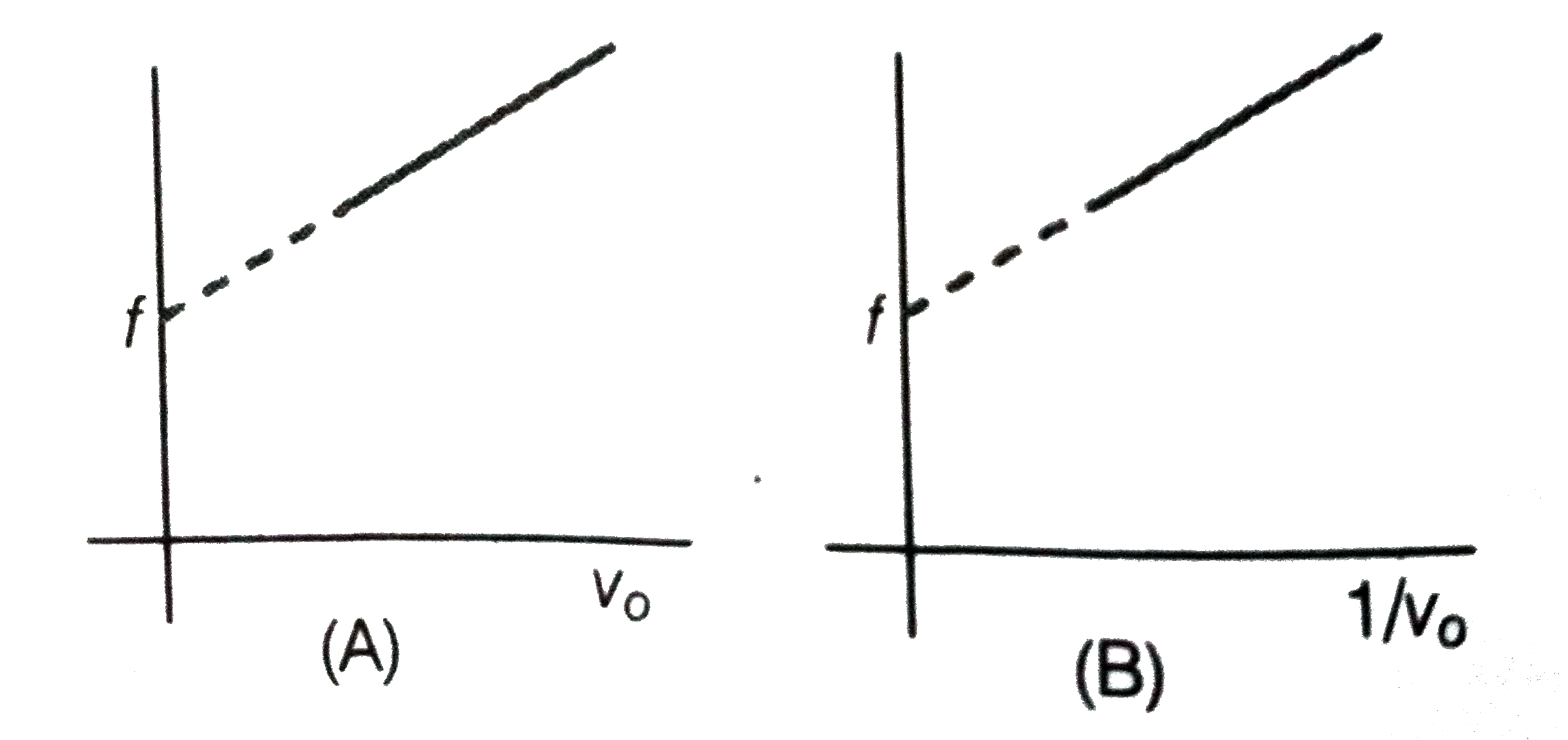A source of sound emits sound waves at frequency f0. It is moving towards an observer with fixed speed vs (vs<v, where v is the speed of sound in air). If the observer were to move towards the source with sped v0, one of the following two graphs (A and B) wil given the correct variation of the frequency f heard by the observer as v0 is changed. The variation of f with v0 is given correctly by

graph A with slope =f0(v+vs)
graph B with slope =f0(v−vs)
graph A with slope =f0(v−vs)
graph B with slope =f0(v+vs)
The correct Answer is:C
According to Doppler's effect, the apparent frequency of sound when both source and observer are moving towards each other
i.e. f=[v+vov−vs]f0⇒f=(vv−vs)f0+(vov−vs)fo
⇒f=(f0v−vs)vo+(f0v−vs)v
As, y=mx+c which is the equation of straight line making an intercept c on y-axis.
So, the slope of the graph =f0v−vs and intercept =vf0v−vs
This condition is represented in graph (A) plotted between F and vo.
Hence, option (c) is correct.
Topper's Solved these Questions
- WAVE MOTIONBook:MHTCET PREVIOUS YEAR PAPERS AND PRACTICE PAPERSChapter:WAVE MOTIONExercise:Exercise 2
Explore 30 Videos
- WAVE MOTIONBook:MHTCET PREVIOUS YEAR PAPERS AND PRACTICE PAPERSChapter:WAVE MOTIONExercise:MHT CET CORNER
Explore 23 Videos
- WAVE MOTIONBook:MHTCET PREVIOUS YEAR PAPERS AND PRACTICE PAPERSChapter:WAVE MOTIONExercise:MHT CET CORNER
Explore 23 Videos
- SURFACE TENSION Book:MHTCET PREVIOUS YEAR PAPERS AND PRACTICE PAPERSChapter:SURFACE TENSION Exercise:MHT CET Corner
Explore 15 Videos
- WAVE THEORY OF LIGHT Book:MHTCET PREVIOUS YEAR PAPERS AND PRACTICE PAPERSChapter:WAVE THEORY OF LIGHT Exercise:MHT CET CORNER
Explore 4 Videos
Similar Questions
The displacement x(in metres) of a particle performing simple harmonic motion is related to time t(in seconds) as x=0.05cos(4πt+π4) .the frequency of the motion will be
View SolutionA progressive wave is represented by y=12sin(5t−4x) cm. On this wave, how far away are the two points having phase difference of 90∘ ?
View SolutionA progressive wave is represented by y=12sin(5t−4x) cm. On this wave, how far away are the two points having phase difference of 90∘ ?
View SolutionIn a capillary tube of radius 'R' a straight thin metal wire of radius 'r' (R>r) is inserted symmetrically and one of the combination is dipped vertically in water such that the lower end of the combination Is at same level . The rise of water in the capillary tube is [T=surface tensiono of water ρ =density of water ,g =gravitational acceleration ]
View SolutionFrom Brewster's law, except for polished metallic surfaces, the polarising angle
View SolutionThe source (S) of sound is moving constant velocity v_(0) as shown in diagram. An observer O listens to the sound emmited by the source. The observed frequency of the sound
View SolutionA source of sound emits sound waves at frequency f0. It is moving towards an observer with fixed speed vs(vs<v where v is the speed in air). If the observer were to move towards the source with speed v0 one of the following two graphs (A and B) will give the correct variation of the frequency f heard by the observer as v0 is changed,
_E01_169_Q01.png)
The variation of f with v0 is given correctly by :-
View SolutionThe source producing sound and an observer both are moving along the direction of propagation of sound waves. If the respective velocities of sound, source and an observer are v,vs and v0, then the apparent frequency heard by the observer will be (n = frequency of sound)
View SolutionA source and an observer are moving towards each other with a speed equal to v2 where v is the speed of sound. The source is emitting sound of frequency n . The frequency heard by the observer will be
View SolutionA source emitting sound of frequency 1000 Hz is moving towards an observer at speed v_s=0.90 v ,(where v is the velocity of sound) . What frequency will be heard by the observer ?
View Solutionthe frequency changes by 10 % as the source approaches a stationary observer with constant speed v_(s) . What would be the percentage change in frequency as the sources reaccedes the observer with the same speed ? Given , that v_(s)lt lt v (v= speed pf sound in air )
View SolutionTwo sources of sound moving with same speed v and emitting frequency of 1400 Hz are moving such that one source s_1 is moving towards the observer and s_2 is moving away from observer. If observer hears beat frequency of 2 Hz. Then find the speed of source. Given v_(sound) gt gt v_(source) and v_(sound) = 350m/s
View Solutionएक ध्वनि स्रोत जिसकी आवृति f है, स्थिर है। एक श्रोता v0 वेग से - (i) स्रोत की ओर, (ii) स्रोत से दूर गतिमान है। श्रोता द्वारा सुनी गयी आभासी आवृति का सूत्र लिखिये । (वायु में ध्वनि की चाल v है )
View Solutionf आवृति का ध्वनि स्रोत vs वेग से स्थिर दीवार की ओर जा रहा है। दीवार द्वारा परावर्तित ध्वनि की आवृति f' का मन लिखिये। (वायु में ध्वनि की चाल v है )
View SolutionVelocity of sound is v. Source and observer move towards each other with velocities V_(s) and V_(0) respectively. Wind is blowing with a velocity v_(m) in the direction opposite to the propagation of sound, n is the frequency of the sound. The apparent frequency of the sound heard by the observer is :-
View SolutionA car moves towards a hill with speed v_(c) .It blows a horn of frequency f which is heard by an observer following the car with speed s .The speed of sound in air is v . find frequency heard by the observer.
View Solution

